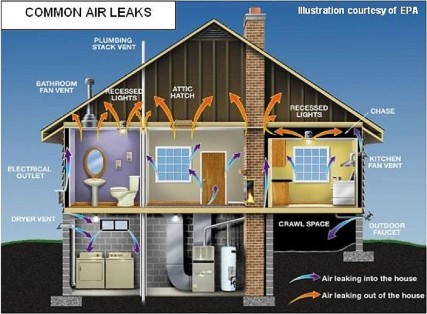Caution! All buildings require a sufficient amount of air exchange. How much air to exchange is determined by building size, occupancy, moisture, odors, and other contaminants. Where to ventilate, when, and how much are questions that need to be asked. Over-ambitious sealing may lead to serious safety and health issues, such as backdrafting heaters, carbon monoxide exposure, high levels of radon, VOC's, moisture, mold, and rot. Sealing ducts in unconditioned spaces can lead to pressure imbalances which can create unintended comfort or health complaints. Diagnostic testing is the initial step in determining your level of building tightness. "You can't manage what you don't measure."
In addition to the holes in your house, there are three factors which determine air exchange rates: 1. Stack Effect (see Improvements page) 2. Weather, wind 3. Mechanical Ventilation Of these three factors, Mechanical Ventilation is the only factor which you can control. |  Your attic needs ventilation to prevent warm moist air from condensing on cold surfaces in the winter, causing mold or rot. Be sure your soffit insulation isn't blocking airflow.
email This Leaky House to measure your infiltration and ventilation rates: drewmcd@verizon.net.
Duct Leakage can be a major cause of energy loss, but sealing duct leaks without testing the improvements can cause rooms to be hot or cold, or cause other safety and health issues. |